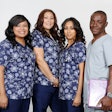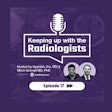AuntMinnie.com · Interview with diagnostic radiologist Andrew Kapustin, MD, of Mecklenburg Radiology Associates in Charlotte, NC
AuntMinnie.com has asked the question about the state of radiology: Is practice building dead?
“The current market demand for teleradiology is so high, it leaves little workforce for the necessary task which must be performed in person and are also required services needed by the contracting facilities or offices staffed by radiology groups," Greg Nicola, MD, chair of the American College of Radiology's Commission on Medical Economics, told AuntMinnie.com in the first of a series of articles on private practice trends in the U.S.
The desire of radiologists to work remotely, payment instability, and the growing involvement of nonphysician investors have stressed private radiology practices.
This series companion podcast episode of "Keeping Up With the Radiologists" features Andrew Kapustin, MD, a diagnostic radiologist at Mecklenburg Radiology Associates, also known as MRA, in Charlotte, NC, with Penn Radiology's Saurabh (Harry) Jha, MD.
MRA is one of the oldest independent radiology groups in the Carolinas, and Kapustin is a former Penn Radiology resident who has been with Mecklenburg since finishing his residency some 20 years ago.
"Time flies," Kapustin said. "I looked around a fair amount and found this one [practice] that seemed to be the right match."
Mecklenburg Radiology Associates dates back to 1917 and James Williamson Squires and Robert (Bob) Hervey Lafferty, two of the earliest radiologists in the Carolinas, according to the practice's website. MRA began by serving what is known today as Novant Health Presbyterian Medical Center and was formally incorporated in 1971. Today, MRA operates as an independent private practice, Kapustin explains in the episode.
"I was given the advice that it's a really good thing to look at all the different options that are out there, even things that you're not sure you'd be interested in -- if for no other reason than to learn the variety of what is out there," Kapustin reflected.
"Coming from an academic center, you get a little bit of a sense of what academics is like, at least in one place," Kapustin continued, "but you get very little sense of what private practice is about, and there's a huge variation in how radiology is practiced, even within private practice.
"Doing all those interviews really helped me get a better sense of what I was looking for and what I really was not looking for," Kapustin said. "I still think about all those other practices and the different models. It just gives you a perspective."
5 points of interest from this episode:
- Kapustin discusses what kinds of qualities and attributes he looks for in new hires. Referring physicians expect a certain level of quality, he said, but he also talks about the breadth, depth, and expectations of the practice which consists of about 70 radiologists. Kapustin also reflects on core rotations that prepare up-and-coming radiologists for opportunities later on. "You just never know what the future holds," he said.
- The episode draws on Kapustin's experience of starting a family during radiology residency. "I had three kids by the time I was a second-year resident," he said. "I wanted to be able to spend time with the family." And, "there's a lot to learn, that you learn while you're in practice."
- Mecklenburg Radiology Associates has maintained its independence as a private practice, although it has been approached to join the trend of consolidation. "What is the secret of your group and why do so many succumb?" Jha asks during the podcast. "We like being our own bosses," Kapustin explains, and at the same time, "rolling up our sleeves to add value to the hospital system."
- Remote reading, on-site, or both? Kapustin describes MRA's approach to remote reading. "We don't want to lose the culture we've established and the reputation we have and our relationships with our referring physicians and administrators," he explained. The full story is in the podcast, however.
- Last but certainly not least, Jha and Kapustin discuss the rise of private equity-owned radiology groups. "It has certainly changed the market; it has certainly changed what's available to people."
More impressions:
{01:01:22} About Andrew Kapustin, MD
{07:51:12} Breadth and depth of radiology
{13:10:19} What the future holds
{14:28:05} Starting a family while a radiology resident
{19;39;28} Beyond med school radiology training
{21:15:11} New type of radiology fellowship
{23:26:16} Independent private radiology practice
{24:08:08} Indispensable hospital partners
{26:42:17} Approach to remote reading
{32:27:20} Private equity in radiology
{35:58:14} Finding the right fit
{39:23:28} Importance of location
{40:59:00} Practice culture
Guest:
Andrew Kapustin, MD, is a board-certified diagnostic radiologist at Mecklenburg Radiology Associates in Charlotte, NC. Kapustin's background includes Harvard University Medical School in Boston, an internship in internal medicine at Brigham and Women's Hospital, a radiology residency at the University of Pennsylvania Health System, and fellowships in cardiovascular radiology and body MRI at the Hospital of the University of Pennsylvania in Philadelphia.
Host:
Saurabh (Harry) Jha, MD, is an associate professor of radiology at the Hospital of the University of Pennsylvania. Jha obtained a master’s degree in health policy research from the Leonard Davis Institute at the University of Pennsylvania. He earned his medical degree from the United Medical and Dental Schools of Guy’s, King’s, and St. Thomas’ Hospitals. Jha developed Value of Imaging, a set of radiology educational resources.
This episode of Keeping Up With the Radiologists is brought to you by AuntMinnie.com in collaboration with Penn Radiology. The series is also available on Spotify, YouTube Music, and Apple Podcasts. Check back for new episodes!




















